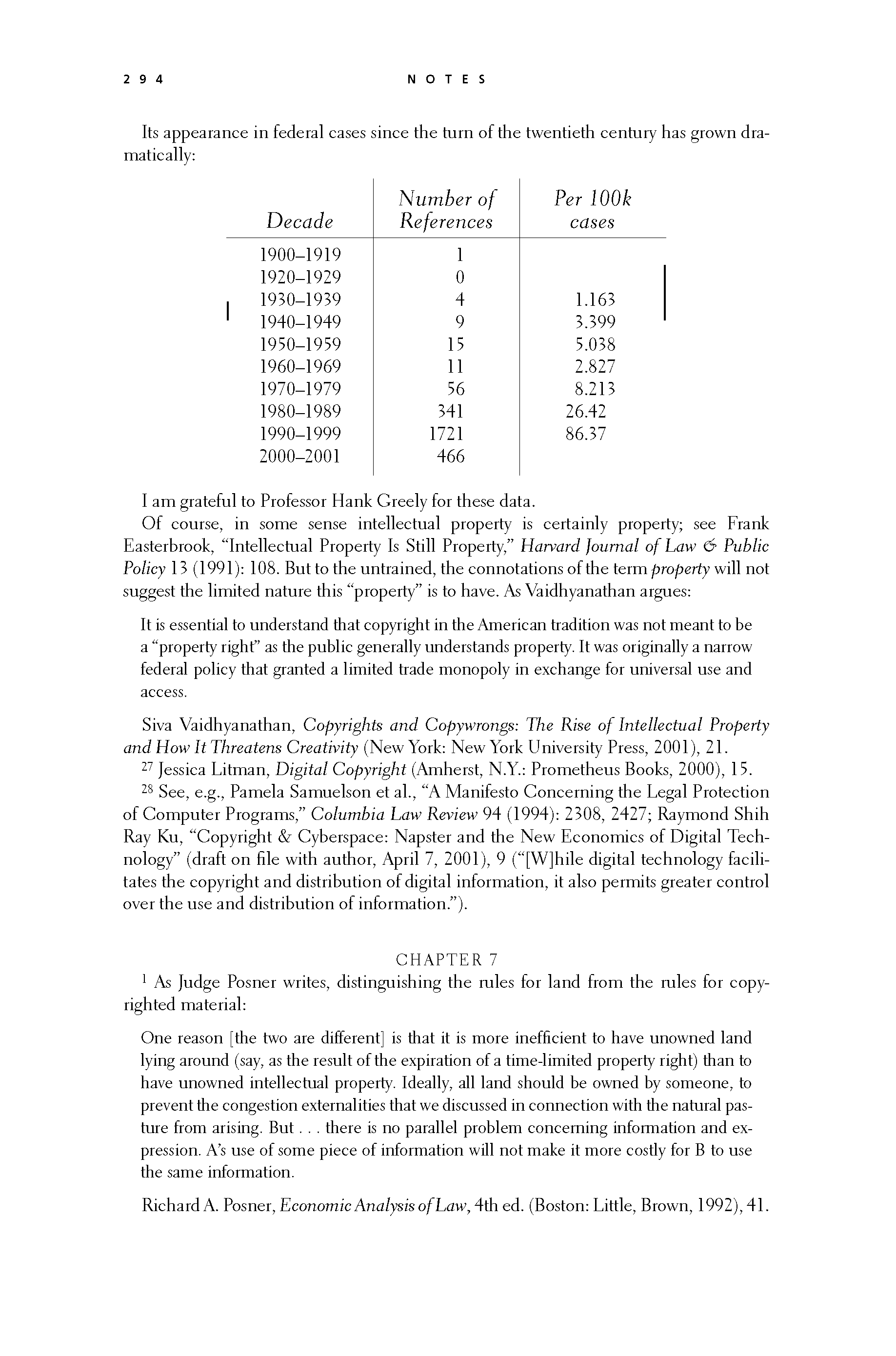 p293 _
-chap- _
toc-1 _
p294w _
toc-2 _
+chap+ _
p295
p293 _
-chap- _
toc-1 _
p294w _
toc-2 _
+chap+ _
p295
Its appearance in federal cases since the turn of the twentieth century has grown dra-
matically:
____ _Number_of_Per_100k_
____ _Decade_References_cases_
____ /tab\ 1900-1919 /tab\ 1
____ /tab\ 1920-1929 /tab\ 0
____ /tab\ 1930-1939 /tab\ 4 /tab\ 1.163
____ /tab\ 1940-1949 /tab\ 9 /tab\ 3.399
____ /tab\ 1950-1959 /tab\ 15 /tab\ 5.038
____ /tab\ 1960-1969 /tab\ 11 /tab\ 2.827
____ /tab\ 1970-1979 /tab\ 56 /tab\ 8.213
____ /tab\ 1980-1989 /tab\ 341 /tab\ 26.42
____ /tab\ 1990-1999 /tab\ 1721 /tab\ 86.37
____ /tab\ 2000-2001 /tab\ 466
I am grateful to Professor Hank Greely for these data.
Of course, in some sense intellectual property is certainly property; see Frank
Easterbrook, "Intellectual Property Is Still Property," _Harvard_Journal_of_Law_&_Public_
_Policy_ 13 (1991): 108. But to the untrained, the connotations of the term _property_ will not
suggest the limited nature this "property" is to have. As Vaidhyanathan argues:
____ It is essential to understand that copyright in the American tradition was not meant to be
____ a "property right" as the public generally understands property. It was originally a narrow
____ federal policy that granted a limited trade monopoly in exchange for universal use and
____ access.
Siva Vaidhyanathan, _Copyrights_and_Copywrongs:_The_Rise_of_Intellectual_Property_
_and_How_It_Threatens_Creativity_ (New York: New York University Press, 2001), 21.
[6-27] Jessica Litman, _Digital_Copyright_ (Amherst, N.Y.: Prometheus Books, 2000), 15.
[6-28] See, e.g., Pamela Samuelson et al., "A Manifesto Concerning the Legal Protection
of Computer Programs," _Columbia_Law_Review_ 94 (1994): 2308, 2427; Raymond Shih
Ray Ku, "Copyright & Cyberspace: Napster and the New Economics of Digital Tech-
nology" (draft on file with author, April 7, 2001), 9 ("[W]hile digital technology facili-
tates the copyright and distribution of digital information, it also permits greater control
over the use and distribution of information.").
Chapter 7
[7-1] As Judge Posner writes, distinguishing the rules for land from the rules for copy-
righted material:
____ One reason [the two are different] is that it is more inefficient to have unowned land
____ lying around (say, as the result of the expiration of a time-limited property right) than to
____ have unowned intellectual property. Ideally, all land should be owned by someone, to
____ prevent the congestion externalities that we discussed in connection with the natural pas-
____ ture from arising. But... there is no parallel problem concerning information and ex-
____ pression. A's use of some piece of information will not make it more costly for B to use
____ the same information.
Richard A. Posner, _Economic_Analysis_of_Law,_ 4th ed. (Boston: Little, Brown, 1992), 41.
[[294]]
p293 _
-chap- _
toc-1 _
p294w _
toc-2 _
+chap+ _
p295